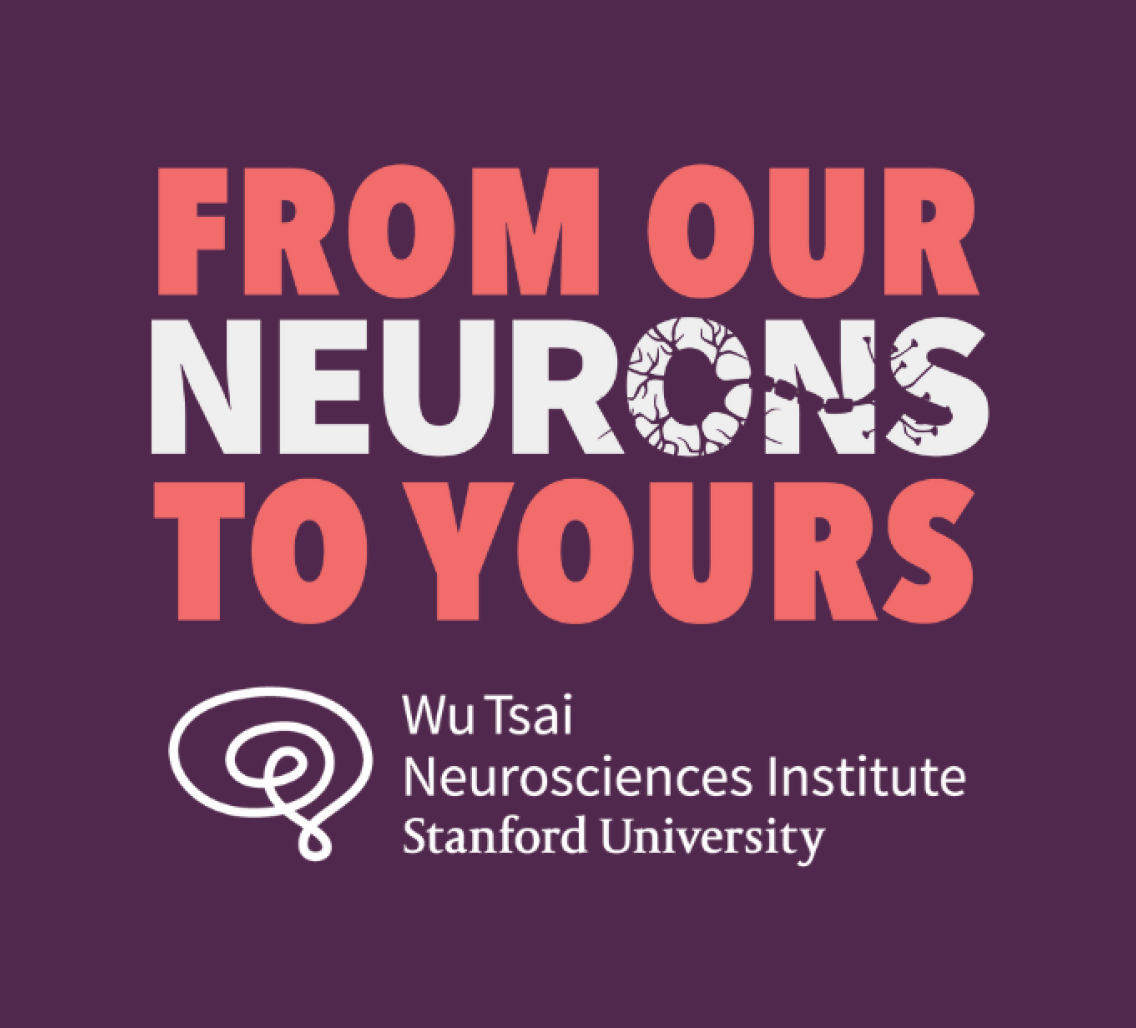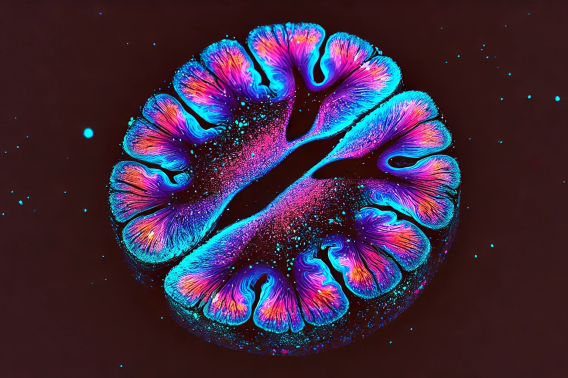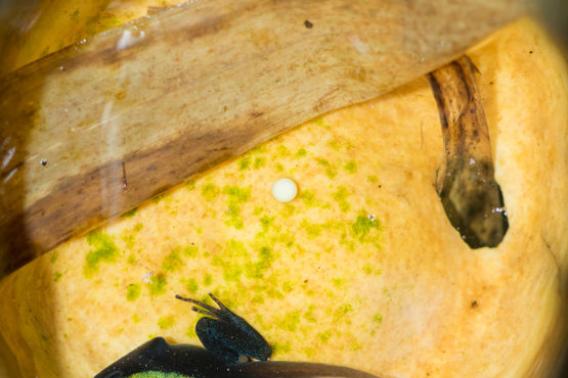Parenting lessons from frogs and spiders

Today we’re going to talk about frogs — and spiders — as parents.
What today’s show is really about is “pair bonding” — that’s the scientific term for the collaborative bonds that form between two parents — as well as the bonds between parents and their offspring. It turns out that if you look across the animal kingdom, strong family bonds are way more widespread than you might imagine. Frogs have them. Spiders have them. Fish have them.
We wanted to learn more about the neuroscience behind these familial bonds across the animal kingdom — and what this could teach us about our own experience as partners and parents. Plus, I just wanted to talk about frogs this week!
Stanford biologist Lauren O’Connell and her lab travel around the world, studying poison frogs, wolf spiders, butterfly fish and other animals that — it turns out — are pretty amazing parents.
Listen to the full episode below, or SUBSCRIBE on Apple Podcasts, Spotify, Google Podcasts, Amazon Music or Stitcher. (More options)
Learn more
O'Connell's research group, the Laboratory of Organismal Biology
Further reading
Frogs in Space (Stanford News, 2022)
Meet a Great Dad From the Animal World: The Poison Frog (KQED, 2022)
Stanford researchers study motherly poison frogs to understand maternal brain (Stanford News, 2019)
Episode Credits
This episode was produced by Michael Osborne, with production assistance by Morgan Honaker, and hosted by Nicholas Weiler. Art by Aimee Garza.
Thanks for listening! Learn more about the Wu Tsai Neurosciences Institute at Stanford and follow us on Twitter, Facebook, and LinkedIn.
Episode Transcript
Nicholas Weiler:
This is From Our Neurons to Yours, a podcast from the Wu Tsai Neurosciences Institute at Stanford University. On this show, we crisscross scientific disciplines to bring you to the frontiers of brain science. I'm your host, Nicholas Weiler.
Here's the sound we created to introduce today's episode.
Perhaps that is the sound of frog parenting. Today we're going to talk about frogs and spiders as parents. Bear with me for a minute. What today's show is really about is the idea of pair bonding, that's the scientific term for the collaborative bonds that form between two parents, as well as the bonds between parents and their offspring. We're obviously familiar with the example of family bonds in our own species, and you probably have ideas about what families look like in animals like wolves, let's say, or swans that mate for life.
But it turns out that if you look across the animal kingdom, strong family bonds are way more widespread than you might imagine. Frogs have them, spiders have them, fish have them. We wanted to learn more about the neuroscience behind these family bonds across the animal kingdom and what this could teach us about our own experience as partners and as parents. Plus, I just wanted to talk about frogs this week. Stanford biologist, Lauren O'Connell and her lab travel around the world studying poison frogs, wolf spiders, butterfly fish, and other animals that it turns out are pretty amazing parents. I started the conversation by asking Lauren to tell me why she studies pair bonding in frogs, her lab specialty.
Lauren O'Connell:
The main reason we study amphibians is because they have a huge diversity in behaviors. So there's some species that where only dads care for offspring, there's some species where only moms do this, and there's some species where they do teamwork to raise their offspring. Then there's some species that they're like, "Hey, I'm going to lay these eggs, then I'm out." And so what we can do then is we can use this behavioral diversity to really dig in to the neuroscience and understand how different neural circuits give rise to different behaviors.
Nicholas Weiler:
So you raise a good point, which is that this is a neuroscience show and parenting behavior feels sort of like that's something that we learn about in biology classes and ecology and so on. So what is the big neuroscience question that motivates you?
Lauren O'Connell:
When I was in graduate school, I was working on my own parental care project. I was pregnant and about to have my first kid-
Nicholas Weiler:
Right. It's very personal. Yes.
Lauren O'Connell:
... And so I was very interested in parental care literature and I found that we understand quite a lot about maternal care from laboratory rodents, but we know very little about what happens in the brains of fathers, mostly because laboratory rodents very rarely display paternal care. And so what I wanted to do was I wanted to study what are the sex differences or similarities in how the brain produces a parental care behavior. And so to be able to do that, I wanted to really disentangle paternal care and maternal care and separate this from pair bonding. Because usually in mammals, when you have males caring for offspring, they also are pair bonded to the mate. And those two neural pathways are really difficult to disentangle.
Nicholas Weiler:
That's really interesting. So maybe we can take a step back. I mean, when did joint parent care evolve in the history of life?
Lauren O'Connell:
It's evolved independently many times, in vertebrates and invertebrates. In each lineage, especially in invertebrates, there has been independent transitions to parental care. And what drives the evolution of pair bonding and parental care can be very different across taxa. So in mammals, we have the definition of being a mammal is like lactation, where moms are caring for offspring. When you're living in an environment where resources are really few and far between, you get pair bonding and paternal care, where it's actually advantageous for the male to actually stick around. But in other animals where lactation is not a requisite or an ancestral feature, there can be lots of different ways and reasons to evolve pair bonding.
Nicholas Weiler:
So I think that I've always assumed that pair bonding is there basically to keep the data around. But it sounds like that is a mammalian perspective to take.
Lauren O'Connell:
Yes. Yeah, I think that's very much a mammal's perspective. So in other taxa, there are other reasons for couples to stick together. For example, in butterfly fish, the reason that they form pair bonds is actually resource defense or territorial defense. So they defend corals that are their food resources and they actually just spawn into the water column. And so there's no parental care at all, but they have these pair bonds. Most of them are male-female pair bonds, but we also find male-male pair bonds and female-female pair bonds, 'cause when it's not tied to offspring, then you get a lot more variation in who is pair bonding with who, that's based on defending a resource. And then in reptile, for example, the only pure bonding reptile is these shingleback skinks that we study in Australia. And it's thought that the reason that they do pair bonding is actually... It interfaces with the immune system because there are lots of parasites around. Individuals that pair bond and only reproduce with a specific individual have less diseases than individuals that are a little bit more promiscuous.
Nicholas Weiler:
Oh, interesting. It's one of these things that we take it very much for granted as this is the way things work in humans and therefore it must be the way things work in other animals. But yeah, it's interesting to hear that about their being so many different strategies. Well, let's dive into some examples because your lab studies some very interesting organisms, both in your lab and out in the field, around the world really. It's very impressive looking through your website just to see all the different animals, the different parts of the world where you're doing this research. Let's start with the poison frogs. Can you describe them for us? What are they like?
Lauren O'Connell:
Sure. So poison frogs have evolved several times this trait of being chemically defended and very colorful. So they're very brightly colored, my favorite frog is blue with black spots. And so that's a male uniparental care species. We do most of our work in Ecuador, in Colombia, and in French Kia. Different species can be wildly different colors and even within the same species they can have very different colorations. Each population has their own little flavor of a pattern and coloration that they've evolved to signal to their predators that they are not a tasty snack.
And all of them display parental care, but that looks different in different species. So in some species, only dads care for offspring and in some species only females do this. And in others they're biparental, they're pair bonding, they're monogamous, and they really have to work together as a team to successfully rear their tadpoles. Just to give you an example, they lay their eggs and the leaf litter, they have to get their tadpoles after they hatch from the leaf litter on the ground to a pool of water because tadpoles are still aquatic. And so they carry them piggyback style to a pool of water. And then in species where mons are involved, they actually come back and feed the tadpoles for several months until the tadpoles complete metamorphosis. And so it's this very energy intensive parental care strategy.
Nicholas Weiler:
I was amazed to read about some of the studies you've done, sort of tracking these little frogs around the forest. As you mentioned, they're laying their eggs and then they've got to take their tadpoles from one place to another and then they've got to come back and feed them. How do you keep track of this behavior?
Lauren O'Connell:
So the size of these frogs are very small compared to what people would be familiar with in a temperate region like the United States. The monogamous species that we study is about the size of your thumbnail, and we have two ways of tracking them. One, we use these frog pants, we call them, these belts where we put little trackers on them and can track where they are moving throughout the forest. And this gives us a sense of where their home range is and where they're putting their tad poles. They put their tad poles in these very specific plants. To me, the forest looks all the same, I'm like, how are they remembering where they're putting their tadpole? And then the other thing that we do is we use these camera traps, both in the field and in the laboratory, that are motion activated, and we put these cameras above the nursery sites where the tadpoles are living, and then we can record any parental interactions.
Nicholas Weiler:
That's so cool. Okay. So what are you learning about the brain circuits behind parental care? You said you're interested in understanding the differences between poison frogs, where the mom takes care of the babies, where the dad takes care of the babies, and where both take care of the babies. So what is that teaching us?
Lauren O'Connell:
I initially thought there would be different brain regions and cell types that are facilitating parental care in males and females. But by comparing all this species, we found that actually there's a core circuit, a core set of cells that promote parental behavior in both sexes. So for example, we have found that these gallons of neurons in the hypothalamus are activated when they do parental care. And these same neurons are also activated during parental care in mammals. There's this core circuit for parental care, and it's the same when you look in a frog and when you look in a mammal. And so-
Nicholas Weiler:
That's incredible.
Lauren O'Connell:
Yeah. So potentially, each time you've evolved parental care, the brain is using the same toolkit. And so now the question we have is, well, what causes this circuit to be activated in some cases but not others? And what are the triggers that are turning on this circuit? And so that's where we're at now.
Nicholas Weiler:
That's so fascinating. I was really also interested in the work you did about feeding the eggs. I mean, in mammals, parenting is closely tied to nursing. You mentioned that in some of these frog species, they also feed the babies their own unfertilized eggs. Why do they do that? And what did you find about the brain circuits? Is it similar to in mammals with nursing?
Lauren O'Connell:
Yeah. So we're very interested in how new behaviors evolve. How do you change brain circuitry to invent a new behavior? In the case of mammals and lactation and infants crying to their mom and things like that, these are very ancestral features of mammals that all mammals share. And so we want to understand how does that arise? How do you invent a new behavior that requires moms and offspring to communicate with one another? And so we started studying the evolution of this egg feeding behavior. In that system, moms visit the tadpoles and then the tadpoles have to communicate that they need food, and they do it with this dance display, it's called begging behavior. This has evolved many times in frogs. And so it also let us look at when you evolve a new behavior, do you always do it the same way?
In this case, we were comparing poison frogs in South America and poison frogs in Madagascar. And what we found is that the behaviors were very similar and then the brain regions that were promoting this behavior were the same. But when we started looking at different cell types and signaling pathways, they were actually very different between species. So for example, the Madagascar frogs seemed to use the oxytocin system similar to mammals to promote maternal care, whereas South American poison frogs don't. And so it suggests that there's this alternative mechanistic solution to promoting maternal care in the South American species.
Nicholas Weiler:
Interesting. So the last thing I want to ask about frogs, and I do want to touch on a couple of other of the animals you're studying briefly, is I was really interested to see you've got a new study that you're working on showing that some of the frogs that do have pair bonds, that do have long-term bonds, seem to have empathy for one another. Could you talk about that a little bit?
Lauren O'Connell:
Yeah. So what we were interested in is this idea that the strength of a pair bond, in some way, depends on your ability to empathize with your partner. The ability to see when they're stressed, the ability to pick up a little bit of slack when they're not feeling well, and this ability to kind of be flexible in the amount of work that you're putting in and kind of in tune to your partner's state. And so this has been shown in mammals and birds, but we also wanted to test, well, these frogs do monogamy, they do pair bonding, so it's probable that they can also do this behavior.
What we did is we ended up replicating a study in mammals where they take one of the partners and they stress them, and then they reunite them, and then they look to see what are the behavioral and hormonal responses of their partner. And so what we found is that in frogs, similar to mammals, whenever the partner is stressed, the focal animal will then mirror their behavior and their hormone levels. So if their partner is stressed and they have high cortisol levels, they will also have increase in cortisol levels even though they were not exposed to a stressor. And we found that the partner's ability to do that kind of predicts their bond strength and how good they are at rearing offspring.
Nicholas Weiler:
Oh, that's fascinating.
Lauren O'Connell:
Yeah, it has real fitness outcomes in these frogs. And I think that for a while, and I was guilty of this too, when we first started this project, it's because most of us have a very mammal centric view of empathy. But even Darwin hypothesizes that empathy was very widespread across the animal kingdom. And in a way that he was right, that even these frogs are able to mirror their hormone in their behavioral state to ensure their offspring survive. And so I think it's something that, through natural selection, has occurred in many different taxa and we just haven't looked very broadly to find it.
Nicholas Weiler:
It's so interesting to hear about what we're learning from these frogs, about the brain circuits of pair bonding and the brain circuits of parental care and how some of these things are shared. The other species I wanted to ask about are the wolf spiders. I think the only thing I know about spider parenting probably comes from Charlotte's Web and it's a sad story. So these wolf spiders, are they good parents?
Lauren O'Connell:
Yeah. Wolf spiders are amazing parents. They do something very similar to the poison frogs, where the moms will carry the egg sac for several weeks, and then when the spiderlings hatch out of this egg sac, she will actually carry them around on her back again for several weeks. And during this whole time, she is not eating, she's only doing this parental care, eventually then the spiderlings will disperse once they're big enough to kind of make it on their own, and then she then goes back to eating and trying to regain some of these nutrients and all the energy lost. And it's very intensive parental care effort.
And so if you think about the life of a spider, caring for a clutch for a month without eating is a huge investment in their offspring. And so what we're interested in is how this behavior that's very similar to parental investment we see in vertebrate taxa, how does this work in the brain? And so we're doing a lot of similar studies where we're looking at what are the brain regions and what are the neural cell types that promote parental care in wolf spiders. There's a lot of variation across species, how long they care for offspring and what that actually looks like, and I think it's a really great comparative system.
Nicholas Weiler:
Yeah. I never knew that spiders could be such good parents. So that brings us sort of back to where we started, thinking about what is the purpose of parental care, what is the purpose of pair bonding. And hearing about all these different species, I'm struck that there is no one answer. Even though there might be common brain circuits that we remarkably share with frogs or fish or even spiders, maybe we'll find out, I guess they've got very different brains, the reasons that animals do pair bonding are very different. What are your takeaways of what we're learning about our own brains and how we do parental care? And does studying these animals give you a different perspective about our own experiences as parents or mates or partners?
Lauren O'Connell:
Yeah. I think it shows that being a parent and being a partner is one, really hard and not something a lot of organisms can do well, and it takes a lot of energy and it takes a lot of empathy and really great communication. And I think this is what we've learned in many of the species that we're working with, being empathetic and being in tune with your partner or your child's emotional state predicts like the strength of that bond and the ability for kids or the offspring to survive and to do really well. Those are the parallels that I see between the animals that we're studying and in my own life.
Nicholas Weiler:
That's beautiful. Yeah. I mean, the struggle is real, but we're not alone. I kind of like that.
Lauren O'Connell:
Right.
Nicholas Weiler:
And it's something that all different species are investing in and making a priority. Well, this is so fascinating. There are so many more really interesting studies and different animals and experiments going on around the world that your lab is doing. I'd love to come back and talk about this more. So thank you so much for coming on the show.
Lauren O'Connell:
Thank you so much for having me.
Nicholas Weiler:
Thanks so much again to our guest, Lauren O'Connell. For more info about her work, check out the links in the show notes. This episode was produced by Michael Osborne with production assistance by Morgan Hanuka. Amy Garza designed our artwork. I'm Nicholas Weiler, see you next time.



